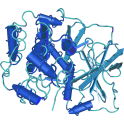
- Remove this product from my favorite's list.
- Add this product to my list of favorites.
Products
Newsletter
 |  |  |  |  |  |

Background: cAMP-dependent protein kinase (PKA) is an ubiquitous serine/theonine protein kinase present in a variety of tissues (e.g. brain, skeletal muscle, heart) regulating several cellular responses by altering the interaction between the catatytic C and regulatory R subunits of PKA. The inactive tetrameric PKA holoenzyme R2C2 is activated when cAMP binds to R2, which dissociates the tetramer to R2*cAMP4 and two active catalytic subunits. Free Catalytic subunits of PKA can phosphorylate a variety of intracellular target proteins. In response to hormone-induced high cAMP levels, PKA phosphorylates glycogen synthetase (inhibition of the enzyme activity) and phosphorylase kinase to block glycogen synthesis.
The α-isoform is the predominant form with a broad tissue distribution and can be used for in vitro enzymological studies of neural and hormonal signal transduction or to phosphorylate target proteins in vivo (via microinjection) including ion channels, transcriptional activator proteins and regulatory enzymes of glycogen metabolism.
Highly active PKA catalytic subunit recombinantly expressed in E. coli and purified using several chromatographic steps. Preferred peptide substrate is kemptide (LRRASLG).
Theoretical MW: 41 kDA
Expression system: E. coli
Storage buffer: 20 mM Mops, 150 mM NaCl, 1 mM DTT, 1 mM EDTA, 50% glycerol
Purity: >95% (SDS-PAGE)
Protein concentration: 0.68 mg/ml (Bradford method using BSA as standard protein)
Specific activity : >30,000,000 U/mg (based on kemptide phosphorylation, 1 unit is defined as 1 pmol phosphate per mg and minute.)
Entrez Gene ID: 18747
UniProtKB: P05132
Ordering information: shipped on dry ice
Figure: Real-time kinetic analysis of kinase inhibitor H-89 binding to PKA Cα using surface plasmon resonance.
Please contact our application specialists to obtain more information and an individual quote tailored to your specific needs.
Taylor SS (1989) "cAMP-dependent protein kinase. Model for an enzyme family" J. Biol. Chem. 264(15):8443-6
Taylor SS, Buechler JA, Yonemoto W (1990) "cAMP-dependent protein kinase: framework for a diverse family of regulatory enzymes" Annu. Rev. Biochem. 59:971-1005
Walsh DA, Glass DB, Mitchell RD (1992) "Substrate diversity of the cAMP-dependent protein kinase: regulation based upon multiple binding interactions" Curr. Opin. Cell Biol. 4(2):241-51
Sculptoreanu A, Rotman E, Takahashi M, Scheuer T, Catterall WA (1993) "Voltage-dependent potentiation of the activity of cardiac L-type calcium channel alpha 1 subunits due to phosphorylation by cAMP-dependent protein kinase" Proc. Natl. Acad. Sci. U S A 90 (21): 10135-9
Walsh DA, Van Patten SM (1994) "Multiple pathway signal transduction by the cAMP-dependent protein kinase" FASEB J. 8(15):1227-36
Tasken K, Skalhegg BS, Jahnsen T et al. (1997) "Structure, function, and regulation of human cAMP-dependent protein kinases" Adv. Second Messenger Phosphoprotein Res. 31:191-204
Gray PC, Scott JD, Catterall WA (1998) "Regulation of ion channels by cAMP-dependent protein kinase and A-kinase anchoring proteins" Curr. Opin. Neurobiol. 8(3):330-4
Diegelmann S, Nieratschker V, Werner U, Hoppe J, Zars T, Buchner E. (2006) "The conserved protein kinase-A target motif in synapsin of Drosophila is effectively modified by pre-mRNA editing." BMC Neurosci. 7:76.
Vaasa A, Viil I, Enkvist E, Viht K, Raidaru G, Lavogina D, Uri A. (2009) "High-affinity bisubstrate probe for fluorescence anisotropy binding/displacement assays with protein kinases PKA and ROCK." Anal Biochem.;385(1):85-93.
Kisseljova K, Kuznetsov A, Baudy-Floc'h M, Järv J. (2011) "Effect of two simultaneous aza-β3-amino acid substitutions on recognition of peptide substrates by cAMP dependent protein kinase catalytic subunit."Bioorg Chem. 2011 Aug;39(4):133-7.
Hromadkova L, Kolarova M, Jankovicova B, Bartos A, Ricny J, Bilkova Z, Ripova D. (2015) "Identification and characterization of natural antibodies against tau protein in an intravenous immunoglobulin product." J Neuroimmunol. 15;289:121-9.
Zerfaß C, Braukmann S, Nietzsche S, Hobe S, Paulsen H. (2015) "High yield recombinant production of a self-assembling polycationic peptide for silica biomineralization." Protein Expr Purif. 108:1-8.
"Antonio Pellegrino ,Denise Danne,Christoph Weigel andHarald Seitz (2023) "An In Vitro Assay to Quantify Effects of Micro- and Nano-Plastics on Human Gene Transcription"Microplastics 2023, 2(1), 122-131; https://doi.org/10.3390/microplastics2010009
Follow us